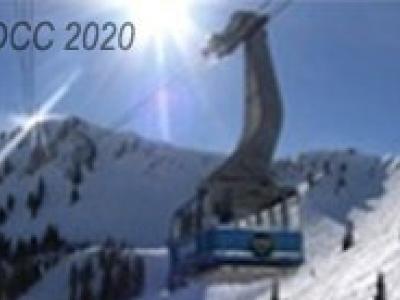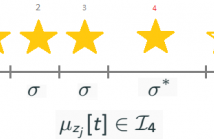
- Read more about 'MEDIA CLASSIFICATION WITH BAYESIAN OPTIMIZATION AND VAPNIK-CHERVONENKIS (VC) BOUNDS
- 1 comment
- Log in to post comments
The automatic classification of content is an essential requirement for multimedia applications. Present research for audio-based classifiers uses short- and long-term analysis of signals, with temporal and spectral features. In our prior study, we presented an approach to classify streaming and local content, in real-time and with low latency, using synthetically-derived metadata features based on fixed class-conditional distributions. The three-class conditional distribution parameters were set a priori based on public information.
- Categories:
 16 Views
16 Views
- Read more about ICASSP 2020 presentation slide of 'EXTRAPOLATED ALTERNATING ALGORITHMS FOR APPROXIMATE CANONICAL POLYADIC DECOMPOSITION'
- Log in to post comments
Tensor decompositions have become a central tool in machine learning to extract interpretable patterns from multiway arrays of data. However, computing the approximate Canonical Polyadic Decomposition (aCPD), one of the most important tensor decomposition model, remains a challenge. In this work, we propose several algorithms based on extrapolation that improve over existing alternating methods for aCPD.
- Categories:
 193 Views
193 Views
- Read more about Machine-Learning-Based Method for Finding Optimal Video-Codec Configurations Using Physical Input-Video Features
- Log in to post comments
Modern video codecs have many compression-tuning parameters from which numerous configurations (presets) can be constructed. The large number of presets complicates the search for one that delivers optimal encoding time, quality, and compressed-video size. This paper presents a machine-learning-based method that helps to solve this problem. We applied the method to the x264 video codec: it searches for optimal presets that demonstrate 9-20% bitrate savings relative to standard x264 presets with comparable compressed-video quality and encoding time.
- Categories:
 130 Views
130 Views
- Read more about Higher-order Count Sketch: Dimensionality Reduction That Retains Efficient Tensor Operations
- Log in to post comments
- Categories:
 29 Views
29 Views
- Read more about DZip: improved general-purpose lossless compression based on novel neural network modeling
- 2 comments
- Log in to post comments
We consider lossless compression based on statistical data modeling followed by prediction-based encoding, where an accurate statistical model for the input data leads to substantial improvements in compression. We propose DZip, a general-purpose compressor for sequential data that exploits the well-known modeling capabilities of neural networks (NNs) for prediction, followed by arithmetic coding. DZip uses a novel hybrid architecture based on adaptive and semi-adaptive training.
- Categories:
 199 Views
199 Views
- Read more about LFZip: Lossy Compression of Multivariate Floating-Point Time Series Data via Improved Prediction
- Log in to post comments
Time series data compression is emerging as an important problem with the growth in IoT devices and sensors. Due to the presence of noise in these datasets, lossy compression can often provide significant compression gains without impacting the performance of downstream applications. In this work, we propose an error-bounded lossy compressor, LFZip, for multivariate floating-point time series data that provides guaranteed reconstruction up to user-specified maximum absolute error.
slides.pdf
- Categories:
 48 Views
48 Views
- Read more about Super-Resolution for Imagery Enhancement Using Variational Quantum Eigensolver
- Log in to post comments
Super-Resolution (SR) is a technique that has been exhaustively exploited and incorporates strategic aspects to image processing. As quantum computers gradually evolve and provide unconditional proof of computational advantage at solving intractable problems over their classical counterparts, quantum computing emerges with the compelling prospect to offer exponential speedup to process computationally expensive operations, such as the ones verified in SR imaging.
- Categories:
 146 Views
146 Views
- Read more about GMM-UBM based Person Verification using footfall signatures for Smart Home Applications
- Log in to post comments
In this paper, we propose a novel person verification system based on footfall signatures using Gaussian Mixture Model-Universal Background Model (GMM-UBM). Ground vibration generated by footfall of an individual is used as a biometric modality. We conduct extensive experiments to compare the proposed technique with various baselines of footfall based person verification. The system is evaluated on an indigenous dataset containing 7750 footfall events of twenty subjects.
- Categories:
 35 Views
35 Views
- Read more about A Multimodal Dense U-Net for Accelerating Multiple Sclerosis MRI
- Log in to post comments
The clinical analysis of magnetic resonance (MR) can be accelerated through the undersampling in the k-space (Fourier domain). Deep learning techniques have been recently received considerable interest for accelerating MR imaging (MRI). In this paper, a deep learning method for accelerating MRI is presented, which is able to reconstruct undersampled MR images obtained by reducing the k-space data in the direction of the phase encoding.
MLSP2019_poster_v4.pdf
- Categories:
 82 Views
82 Views
- Read more about A WEIGHTED ORDERED PROBIT COLLABORATIVE KALMAN FILTER FOR HOTEL RATING PREDICTION
- Log in to post comments
A successful recommender system interacts with users and learns their preferences. This is crucial in order to provide accurate recommendations. In this paper, a Weighted Ordered Probit Collaborative Kalman filter is proposed for hotel rating prediction. Since potential changes may occur in hotel services or accommodation conditions, a hotel popularity may be volatile through time. A weighted ordered probit model is introduced to capture this latent trend about each hotel popularity through time.
- Categories:
 65 Views
65 Views